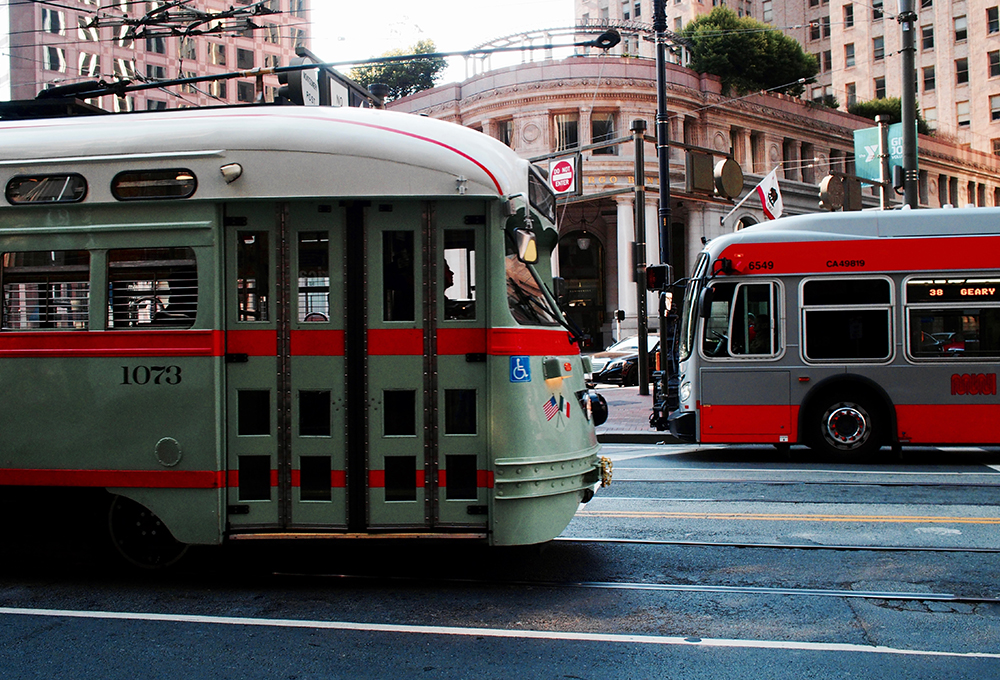Jump to section
Mobility Hub Elements
Mobility Hubs incorporate physical, programmatic, and digital elements to serve transportation and placemaking goals.

Photo by Daniel Adams on Unsplash
Mobility Hubs are an opportunity to create seamless transportation and nodes of neighborhood activity. Mobility hubs are part of the transportation and public space networks and should be designed to be welcoming, useful, and active places that relate to their local context and community.
Issues & approaches
Active and Public Transportation Infrastructure: Mobility hubs should be located within a robust network of public transportation and active transportation infrastructure. For pedestrians, sidewalks need to be accessible (level, adequate width) and safe (lighting, crossing enhancements). For bicycles, it is essential to provide safe bike routes (multi-use paths, bike lanes) and parking, as well as supporting features such as lockers and repair stations. For buses, physical and service adjustments should enable more reliable, on-time bus services (dedicated transit lanes, bus signal prioritization, bus layover zones).
New-mobility related infrastructure: Mobility hubs can make new mobility services more accessible by providing free wifi, phone charging and kiosks as well as the following physical elements:
- Micromobility. These services should be organized to preserve an accessible pedestrian pathway, such as designated parking corrals or docks on the sidewalk or former on-street parking space.
- Microtransit. These buses or vans should have a designated pickup/dropoff zone with signage, shelter, seating and lighting. Their schedule should be incorporated into real-time-information at the mobility hub.
- Carshare. Dedicated parking spots for carshare vehicles should be located at or within walking distance from the mobility hub with wayfinding and signage.
- TNCs. Dedicated pickup and dropoff zones should be allocated to avoid conflict with bus and microtransit pickup and dropoff, as well as adequate seating, shelter, and lighting for waiting passengers.
Streamlined Transfers and Improved Waiting Experience: Mobility hubs should make it easy to access, wait for and transfer between modes. Services and design elements to achieve this include:
- Real-Time Travel Information: Up to date arrival, departure, and delay information for transit, delivered in an app, signage, or interactive kiosk.
- Smart Parking: Uses technology to make paying and searching for parking more efficient, such as pay-by-phone, in-street sensors, and parking reservation systems.
- Passenger Loading Zones: May include dedicated loops for larger vehicles or zones along the curb that rotate according to peak usage times.
- Static and Interactive Wayfinding: Helps people navigate to points of interest and provides mobility information on routes, schedules, and payment options.
- Mobility-as-a-service Apps and Kiosks: Offers multimodal trip planning and payment.
- Seating and Shelter: Places to sit, set down a bag, and shelter from rain or sun.
Non-Transportation Related Design Considerations:
- Experiential & Practical Retail: Mobility hubs benefit from adjacent active land uses such as ground floor retail and the inclusion of kiosks, carts, or pop-up vendors within the station area. In addition to food, there is interest in including typical errands such as dry cleaning, salons, and e-commerce package delivery lockers.
- Placemaking: High quality, context-sensitive materials, planting, furnishings, and public art should be thoughtfully integrated with the transportation elements. Mobility hubs have the potential to act similar to parklets, where designers and local partners transform a formerly utilitarian space to meet local needs.
- Programming: Mobility hubs can serve as a gateway to an unfamiliar area and a distributed node of community information and activity. Mobility hubs can be staffed with ambassadors to provide wayfinding and mobility recommendations, or programmed much like a public plaza with a variety of performances, pop-up festivals, and civic events in partnership with area schools, libraries, and community centers.
- Design for the most vulnerable populations: Furnishing, wayfinding, materials, and programming should be welcoming for a wide range of users and types of trips, such as families with small children, older adults, people with reduced mobility, people hauling large packages, people who speak various languages.
Examples/case studies

Mobility Hubs: A Reader's Guide
View - Urban Design Studio
Drawing from experience in Los Angeles, the City’s Urban Design Studio outlines different features of mobility hubs and best practices for implementation.

Mobility Hub Features Catalog
View - San Diego Association of Governments
The San Diego Regional Mobility Strategy webpage contains a variety of resources about mobility hubs.
Related topics

Right of Way Redesign
Redesigning and reallocating space in the Right-of-Way can better support emerging transportation modes.

Transit
Transit is the most efficient way of moving people, but many transit systems are facing challenges. What happens when AVs arrive?

Old Rules are Still New Rules
Even as the transportation landscape rapidly changes, many existing design principles still apply.
See something that should be here that isn't? Have a suggestion to make?

